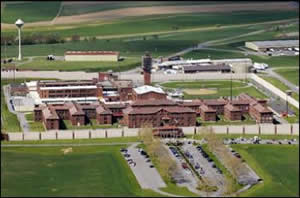
Valentine’s Day 1970 was a brisk day in the small town of Lewisburg, Pennsylvania, with the cool breeze blowing across the vast farmland. Love was not the only thing in the air, however; an airplane was trailed by a flowing banner, which stated, “Happy Birthday, Jimmy!” Lewisburg’s residents gazed into the sky wondering who would go through the effort of hiring an airplane simply to wish someone a happy birthday. They stared in awe, only to realize that the banner was intended for one of Lewisburg’s more temporary and undoubtedly notorious residents, Lewisburg Federal Penitentiary inmate, Jimmy Hoffa. Jimmy Hoffa, who was the president of the Teamsters’ union during the late 1950s to the early 1970s, mysteriously disappeared in 1975. Although the prison goes virtually unnoticed by Lewisburg’s residents, its importance to United States’ security combined with its extensive list of infamous inmates have left a permanent mark on the nation’s history.
The Lewisburg Federal Penitentiary is one of 114 United States institutions for criminals who have committed federal offenses. In 1930, Attorney General William D. Mitchell announced that Lewisburg would be the site of a new federal prison to serve the northeastern states. Proposed as a “model” Federal penitentiary, the prison was intended to serve the Eastern seaboard from New England to Virginia. Lewisburg was chosen as the site of the new prison for a variety of reasons. When the New York Times reported on Mitchell’s announcement, it said Lewisburg was chosen for its “central location and proximity to large centres of population; the adaptability of the site for agricultural development…the presence of superior facilities in the form of railroads, highways, gas and water supply.”
The prison, then called the Northeastern Penitentiary, opened in 1932 as the fourth national federal prison for men. It is now a maximum-security facility home to approximately 1,500 inmates. The penitentiary’s grounds also contain a satellite prison camp that houses minimum-security offenders who have been convicted of non-violent federal crimes. The prison was designed by architect Alfred Hopkins, who was inspired by French Renaissance style architecture. Although the facility is protected by several large brick walls, as well as metal and barbed wire fences, the penitentiary itself is adorned with gothic arches, terra cotta brick, and ornamental corbels. According to Michael Santos, a former inmate at the Lewisburg Penitentiary, “The penitentiary has a gothic, almost spooky architecture.” Despite the fact that the Lewisburg Penitentiary appears to be a quiet, secure, and virtually harmless facility to the Lewisburg community, the prison houses some of the nation’s most violent criminals, those who have greatly affected the history of this country.
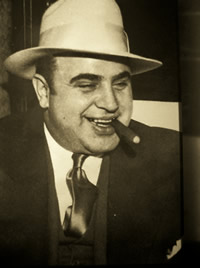
In addition to infamous Teamsters’ president Jimmy Hoffa, Lewisburg has been the temporary home to some of America’s most controversial and intriguing criminals, such as mobsters John Gotti, Al Capone, and Henry Hill. In fact, the Lewisburg Penitentiary has been known to house so many organized crime inmates that a certain area of the prison has been dubbed “Mafia row.” Al Capone, also known as “Scarface,” served nearly three years in the Lewisburg Penitentiary for his role as one of the leaders of Chicago’s organized crime, as well as for federal income-tax evasion. Most people associate Al Capone with a well-dressed, powerful, even arrogant man, the prototype of today’s stereotypical Mafia gangster. Very few people are aware of the grave impact that prison life had on Capone. According to the biography, Capone, by Laurence Bergreen, Al Capone left Lewisburg Penitentiary a very different man:
The convict Mae and Sonny retrieved from the Lewisburg Penitentiary bore only a superficial and haunting resemblance to the sleek, confident, well-dressed Capone who had entered the Cook County Jail that long-ago day in October 1931. The man who stood before them now, grinning lopsidedly, a trail of spittle trickling from the corner of his mouth, had the demeanor of a jailbird, timid and wary.
Besides Mafia leaders, the Lewisburg Penitentiary has housed other famous men, including civil rights leader Bayard Rustin and accused Soviet spy Alger Hiss. Rustin, an active Quaker, was imprisoned in 1943 for not registering in the draft and for choosing not to serve in alternate service activities during WWII. Rustin spent three years at Lewisburg for this offense. Alger Hiss served time in Lewisburg for perjury. Literature helped Hiss make it through his 44-month sentence. He was only able to withstand the prison by "having more leisure to read books of my own choosing than I had had since childhood."
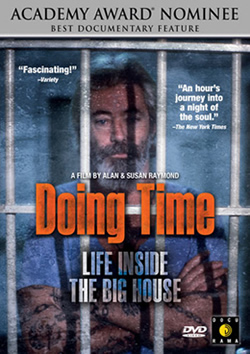
The Lewisburg Penitentiary received even more notoriety when it was chosen as the location for the Emmy Award-winning documentary, Doing Time: Life Inside the Big House. The filmmakers, Alan and Susan Raymond, were granted full access to the Lewisburg Penitentiary grounds and facility by the Federal Bureau of Prisons, a privilege even the filmmakers themselves were surprised to receive. The couple spent six weeks, and filmed one hundred hours of footage, inside the prison walls in 1990. The Raymonds focused on what they called the “lifers,” inmates who had no possibility of parole and were guilty of some of the most vicious crimes. The film depicts an area of the prison where inmates are held under solitary confinement for twenty-three hours every day. Two prisoners are held in a six by eight foot cell that was meant to house only one man. There are also many Cuban drug cartel members held at Lewisburg under solitary confinement every hour of the day. The Raymonds explain that the United States government tried to extradite them back to Cuba, but the Cuban government refused to receive them. The documentary is an eye-opening work that shows the “other world” behind the walls of the Lewisburg Penitentiary.
In 2007, the prison celebrated its seventy-fifth anniversary. As the result of an aging prison population, there are multiple inmates older than the prison itself. Since Lewisburg has no means to handle serious health-care issues, these aging prisoners often have to be moved to other facilities if their health fails. Aside from this, Warden Troy Williamson believes Lewisburg is “an old institution that is very stable.” He goes on to say that, “Lewisburg has had a history of dealing with challenging inmates and doing it successfully…this is a high-security facility. There are some very dangerous people here… we try to deal with things without resorting to harsh treatment. A well-run institution is a safe institution and we are safe.”
Lewisburg Penitentiary’s history of experienced staff and top-notch security, which have made it an ideal location to place some of America’s highest profile criminals, undoubtedly caused the prison to receive its latest upgrade. As of January 2009, the Lewisburg Penitentiary has become the country’s first super maximum-security facility. The decision to select Lewisburg for the location of the nation’s only super maximum-security prison came easily to officials. “It’s the only institution with a special unit, and its staff has the reputation of being highly trained and experienced” reported Traci Billingsely, a Federal Bureau of Prisons spokeswoman.
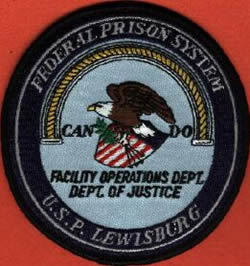
Since January 2009, “the worst of the worst,” so called by Lewisburg prison’s chief union steward, Craig Wheeland, have been housed at the Lewisburg Federal Penitentiary. The prison is now home to those inmates who were dubbed the most disruptive and difficult to control at other federal prisons around the country. These inmates pose such grave and serious danger to themselves and others that they now spend twenty-three hours a day locked up in a tiny prison cell. According to Scott Finley, executive assistant at Lewisburg Penitentiary, “the plan is to expand the special management unit, which currently houses six percent of the penitentiary’s 1,500 inmates, to encompass the entire institution.” The Lewisburg Penitentiary has received a great deal of national attention with regards to its security boost. It will serve as an experimental model for the nation’s other 113 federal prisons, which may someday be faced with the same security upgrade that Lewisburg is currently undergoing.
With the security upgrade and influx of dangerous prisoners has come a staffing shortage. Tony Liesenfeld, secretary and treasurer of the local union of the American Federation of Government Employees, blames this shortage for the increase in violence at the Lewisburg prison. There have been 44 violent incidents at the prison so far this year, which accounts for over 11 percent of the total violent episodes reported in 44 institutions nationwide. These clashes involve fights between inmates as well as attacks on staff members. Liesenfeld argues that the Lewisburg penitentiary was not designed to house such dangerous inmates and the lack of workers has clerical staff performing the duties of corrections officers. Liesenfeld concludes, “We have the best staff, but at the same time, you can’t get something done, if you don’t have the bodies.” Bryan Lowry, president of Council of Prison Locals 33, American Federation of Government Employees says, “It’s irresponsible and dangerous with the current staffing levels,” and believes it is only a matter of time before someone is seriously injured or killed.
The Lewisburg Prison Project would like to help. The project, founded in 1973, has been an advocate for inmates’ rights, yet in this case would like to aid the corrections officers. Angela Trop, a board member for the project, said “I would love to help this union.” The project was founded on the belief that though the inmates have made poor choices in the past, they still have rights. Trop says, “These inmates could be my neighbors, my family members. They had to be removed because they wronged us, but if you feel blessed, you have to help anyone who is oppressed.”
This idea of giving back is by no means a one-way street; Lewisburg inmates have also done their part to give back to the community. Joseph Dugan, who spent time in the minimum-security camp at the Lewisburg Federal Penitentiary for money laundering and bank fraud, has put his creative energy to good use for the Lewisburg community. Dugan lead a group of inmates who spent their free time building floats for the Lewisburg community parades. One of their efforts, a race car that turned into a football player when raised vertically, took first prize in the Bucknell University homecoming parade. They also entered a float resembling a stagecoach in the Victorian Holiday Décor Parade in Lewisburg. David Combs, the minimum-security camp administrator believes that “Floats are an excellent way to serve the community. We provide the labor and creativity.”
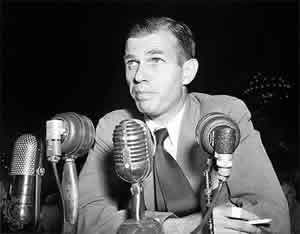
Inmate Tom Boskey has reached out to the community in another way. A former All-America linebacker for Iowa State, Boskey was convicted of mail fraud, tax evasion, and racketeering. After realizing his mistakes, he chose to share his story with local schools to teach children that “people from all walks of life can make wrong decisions.” J. Paul Horner, the Intensive Confinement Center administrator at the Lewisburg Federal Penitentiary, organized four-man teams of inmates with varying backgrounds to visit local schools. Accompanying Boskey were embezzler Paul Doughty, and drug traffickers Gabriel Longoria and David Nestler. Frank Corbin, who works with Lewisburg students about to be suspended, said that student reaction to the talks had been positive.
To look beyond the strong brick walls and eerie façade of the Lewisburg Federal Penitentiary is to discover a world unknown to all but the few who may never again see outside them. Each inmate has his own story; some have merely affected people’s lives while others have forcibly taken them. Nevertheless, they have all made their infamous mark on history in some way. With the prison’s promotion to super maximum-security status, it is all but guaranteed that it will continue to house the country’s most notorious names and violent villains. Yet the examples of Boskey, Doughty, and the Lewisburg Prison Project indicate a strong reciprocal relationship between the prison and the Lewisburg community. With inmates working to discourage crime in today’s youth and Lewisburg locals looking to provide assistance to those already behind bars, there is hope of creating a more crime-free tomorrow.
Sources:
- Beauge, John. “Inmates gain recognition as float builders//Talent finds outlet in Lewisburg.” The Patriot-News [Harrisburg] 26 Nov. 1995: A4.
- Beauge, John. “Inmates share mistakes to help young people.” The Patriot-News [Harrisburg] 7 May 1995: B11.
- Bruno, Anthony. “The Disappearance of Jimmy Hoffa.” TruTV Crime Library. 2008. Turner. 31 Mar. 2009 <http://www.trutv.com/library/crime/notorious_murders /famous/jimmy_hoffa/3.html>.
- Dandes, Rick. “‘Doing Time’ in the big house.” The Daily Item 23 Oct. 2008. 31 Mar. 2009 <http://www.dailyitem.com/archivesearch/local_story_297083034.html>.
- Dandes, Rick. “Penitentiary Turns 75 (check the cake).” McClatchy-Tribune Business News [Washington] 18 Nov. 2007.
- Doing Time: Life Inside the Big House. Prod. Alan Raymond and Susan Raymond. DVD. Newvideo, 1991.
- “Inmate: Lewisburg Federal Penitentiary.” NNDB. Soylent Communications, 2009. 31 Mar. 2009. <http://www.nndb.com/>.
- Laepple, Wayne. “Union fears for penitentiary guards.” The Daily Item 4 June 2009. 28 Oct. 2009. <http://www.dailyitem.com/archivesearch/local_story_155230022.html>.
- Lehmann-Haupt, Christopher. “Books of the Times Alger Hiss Recalls Emotional Side of His 2 Trials.” New York Times 12 May 1988: 33.
- “Lewisburg, Pa., gets new Federal Prison.” New York Times 1 Aug. 1930: 14.
- Lowe, Benjamin Y. “Naming of school opens rift - Some balk at honoring a civil rights leader who defied WWII military duty.” The Philadelphia Inquirer 20 Nov. 2002: A01.
- Moore, Marcia. “Prison Project honors board member.” The Daily Item 7 June 2009. 28 Oct. 2009. <http://www.dailyitem.com/archivesearch/local_story_158074817.html?start:....
- Morton, Gina. “Union: Danger on rise at pen.” The Daily Item 28 Oct. 2009. 28 Oct. 2009. <http://www.dailyitem.com/archivesearch/local_story_301000431.html>.
- North, Jamie. “Come January, penitentiary to house nation’s toughest.” The Daily Item 9 Nov. 2008. 31 Mar. 2009 <http://www.dailyitem.com/archivesearch/local_story_ 314083712.html>.
- Santos, Michael. “Prisoners of USP Lewisburg.” USP Lewisburg Descriptions Courtesy of MichaelSantos.net. 2008. 31 Mar. 2009 <http://www.unitedstatespenitentiarylewisburg.com/prisoners.html>.
